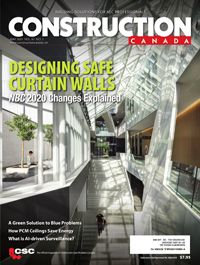Adhered ceramic tile and stone façades weather and shock-resistant installations
Surviving the 2010 earthquake in Chile
Unfortunately, natural disasters—such as high winds and seismic events—are a threat in many parts of the world, including, in varying degrees, parts of Canada. Building owners and design/construction professionals are concerned with the performance of their structures in the face of these events.
Traditional site-mixed masonry mortars and low-performance ceramic tile and stone adhesives can fall short in their ability to withstand the demanding conditions ceramic tile and stone installations typically face—most standard products simply do not have the adhesion strength or durability to withstand the rigors of such demanding installations. Therefore, many of these installations experience bond failure as the veneer separates from the substrate and can eventually fall off the building.
In many cases, inferior adhesive mortars do not even achieve minimum code-prescribed shear bond strength requirements. In the United States, the International Building Code (IBC) calls for 345 kPa (50 psi). In Canada, the building codes are less definitive and typically place the burden of design on the specific project engineering teams. Additionally, the Terrazzo, Tile, and Marble Association of Canada (TTMAC) details and specifications refer to American National Standards Institute/International Organization for Standardization (ANSI/ISO) standards for installation performance parameters.
Therefore, specifiers should prescribe high-performance, latex-fortified, portland-cement-based thin-bed adhesive mortars meeting ANSI A118.15, Improved Modified Dry-set Cement Mortar, and ISO 13007-1, Ceramic Tile Adhesive/Grouts, performance level of C2TES1P1 (Figure 2).
These adhesive mortar types have historically demonstrated they can withstand the live loads, lateral forces, and, for regions with seismic activity, shearing force exerted on the ceramic tile or stone cladding. It is important to note this last force is by far the most extreme an adhesive bond must be able to endure on exterior building façades. Thermal movement, thermal-induced structural deflection, and wind forces will also induce shearing forces similar to those exerted by seismic activity.
For example, the shear stress exerted by an earthquake of a magnitude of 7 on the Richter scale is about 1.5 MPa (215 psi). It is reasonable to conclude this would be the minimum safe shear bond strength of the cladding, adhesive, and substrate interfaces. In light of this, it is important for an adhesive mortar to achieve even higher shear bond strength values to compensate for conditions during the installation that can result in a lower ultimate shear bond strength value.
Over the past few years, the ceramic tile and stone installation industry has seen a movement toward more flexible, low-shear-modulus adhesives in lieu of high-shear-strength/high-shear-modulus adhesive mortars for demanding applications such as exterior façades. Contrary to the belief highly flexible/low-shear-modulus adhesives are suitable for these applications, proprietary fatigue testing and empirical history have shown stress placed on such adhesives are unrecoverable, which in turn reduces the amount of stress the adhesive can withstand from other subsequent forces.
In the same fatigue testing, high-shear-strength/high-shear-modulus adhesive mortars exhibit very little fatigue degradation at stress levels 33 to 40 per cent of their ultimate shear strength. The more flexible low-shear-modulus adhesives will exhibit significant fatigue degradation at stress levels 27 per cent of their ultimate shear stress. Additionally, long-term loading (such as thermal loads) have little effect on the shear strength of high-shear-modulus adhesives, while more flexible, low-shear-modulus adhesives actually lose strength with duration of load. Polymer-fortified cement adhesives formulated to provide a balance between high-shear modulus and moderate flexibility have a 50-year proven history of successful applications.
The Edificio Alonso de Cordova in Santiago, Chile survived the 8.8 Richter scale earthquake (and the numerous aftershocks), which occurred on February 27, 2010 (Figure 3). This earthquake was the second-strongest earthquake in the past century to affect the Santiago area. This reinforces the fact building structures must be designed and utilize installation materials to withstand these potentially catastrophic events.
An examination of past earthquakes and their effect on direct-adhered ceramic tile and stone cladded buildings reveals high-shear-modulus adhesive mortars are the correct choice for these applications. For example, the Northridge earthquake, which struck the northern California region in 1994 caused the Bullock’s department store to collapse during the seismic event (Figure 4). However, the thin brick finish—which was installed with a high-shear-strength/moderate-shear-modulus cement adhesive mortar—remained firmly attached to the cement plaster substrate. Although the building collapsed, not one thin brick sheared from the substrate. This provides practical evidence of how the appropriate adhesive mortar type is necessary for long-term performance of ceramic tile- and stone-cladded building structures.
Resistance to building creep and wind drift are realities that building veneers must face and resist. In addition, ‘shearing forces’ induced by thermal movement are similar to, and can mimic, seismic activity. While not all building zones require seismic resistance, the security of knowing an installation system can withstand an event of this type is most reassuring.
In order to achieve the performance required to withstand the forces that buildings have to endure, a complete installation system for the cladding must be specified early on during the design phase and enforced during the construction phase. The installation materials include:
- high-shear-modulus cement adhesive;
- waterproofing/crack-isolation membrane;
- high-performance polymer-modified cement grout;
- 100 per cent silicone sealant; and
- polymer-fortified levelling mortars.







